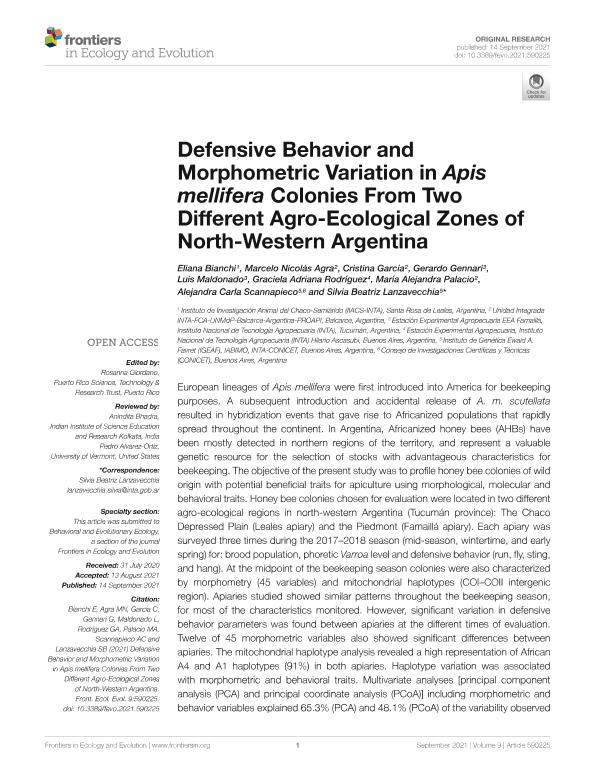Mostrar el registro sencillo del ítem
dc.contributor.author
Bianchi, Eliana
dc.contributor.author
Agra, Marcelo Nicolás

dc.contributor.author
García, Cristina
dc.contributor.author
Gennari, Gerardo Pablo

dc.contributor.author
Maldonado, Luis María

dc.contributor.author
Rodriguez, Graciela Adriana

dc.contributor.author
Palacio, Maria Alejandra

dc.contributor.author
Scannapieco, Alejandra Carla

dc.contributor.author
Lanzavecchia, Silvia Beatriz

dc.date.available
2023-12-04T11:25:39Z
dc.date.issued
2021-09
dc.identifier.citation
Bianchi, Eliana; Agra, Marcelo Nicolás; García, Cristina; Gennari, Gerardo Pablo; Maldonado, Luis María; et al.; Defensive Behavior and Morphometric Variation in Apis mellifera Colonies From Two Different Agro-Ecological Zones of North-Western Argentina; Frontiers Media S.A.; Frontiers in Ecology and Evolution; 9; 9-2021; 1-13
dc.identifier.issn
2296-701X
dc.identifier.uri
http://hdl.handle.net/11336/219135
dc.description.abstract
European lineages of Apis mellifera were first introduced into America for beekeeping purposes. A subsequent introduction and accidental release of A. m. scutellata resulted in hybridization events that gave rise to Africanized populations that rapidly spread throughout the continent. In Argentina, Africanized honey bees (AHBs) have been mostly detected in northern regions of the territory, and represent a valuable genetic resource for the selection of stocks with advantageous characteristics for beekeeping. The objective of the present study was to profile honey bee colonies of wild origin with potential beneficial traits for apiculture using morphological, molecular and behavioral traits. Honey bee colonies chosen for evaluation were located in two different agro-ecological regions in north-western Argentina (Tucumán province): The Chaco Depressed Plain (Leales apiary) and the Piedmont (Famaillá apiary). Each apiary was surveyed three times during the 2017–2018 season (mid-season, wintertime, and early spring) for: brood population, phoretic Varroa level and defensive behavior (run, fly, sting, and hang). At the midpoint of the beekeeping season colonies were also characterized by morphometry (45 variables) and mitochondrial haplotypes (COI–COII intergenic region). Apiaries studied showed similar patterns throughout the beekeeping season, for most of the characteristics monitored. However, significant variation in defensive behavior parameters was found between apiaries at the different times of evaluation. Twelve of 45 morphometric variables also showed significant differences between apiaries. The mitochondrial haplotype analysis revealed a high representation of African A4 and A1 haplotypes (91%) in both apiaries. Haplotype variation was associated with morphometric and behavioral traits. Multivariate analyses [principal component analysis (PCA) and principal coordinate analysis (PCoA)] including morphometric and behavior variables explained 65.3% (PCA) and 48.1% (PCoA) of the variability observed between colonies in the first two components. Several morphometric parameters and “fly” behavior were mainly associated with the separation of the colonies. The results from this study point to a possible association between morphometric and behavioral variation and the adaptation of honey bee colonies to differential agro-ecological conditions. We discuss how the detected variation between apiaries can be used for the selection and preservation of honey bee ecotypes in regional breeding programs.
dc.format
application/pdf
dc.language.iso
eng
dc.publisher
Frontiers Media S.A.

dc.rights
info:eu-repo/semantics/openAccess
dc.rights.uri
https://creativecommons.org/licenses/by-nc-sa/2.5/ar/
dc.subject
DEFENSIVENESS
dc.subject
ENVIRONMENT
dc.subject
HONEY BEES
dc.subject
MITOCHONDRIAL HAPLOTYPE
dc.subject
MORPHOMETRY
dc.subject.classification
Genética y Herencia

dc.subject.classification
Ciencias Biológicas

dc.subject.classification
CIENCIAS NATURALES Y EXACTAS

dc.title
Defensive Behavior and Morphometric Variation in Apis mellifera Colonies From Two Different Agro-Ecological Zones of North-Western Argentina
dc.type
info:eu-repo/semantics/article
dc.type
info:ar-repo/semantics/artículo
dc.type
info:eu-repo/semantics/publishedVersion
dc.date.updated
2023-12-04T10:13:24Z
dc.journal.volume
9
dc.journal.pagination
1-13
dc.journal.pais
Suiza

dc.description.fil
Fil: Bianchi, Eliana. Instituto Nacional de Tecnologia Agropecuaria. Centro de Investigaciones Agropecuarias. Unidad de Estudios Agropecuarios. Grupo Vinculado Instituto de Investigacion Animal del Chaco Semiarido A la Udea | Consejo Nacional de Investigaciones Cientificas y Tecnicas. Centro Cientifico Tecnologico Conicet - Cordoba. Unidad de Estudios Agropecuarios. Grupo Vinculado Instituto de Investigacion Animal del Chaco Semiarido A la Udea.; Argentina
dc.description.fil
Fil: Agra, Marcelo Nicolás. Instituto Nacional de Tecnología Agropecuaria. Centro Regional Buenos Aires Sur. Estación Experimental Agropecuaria Balcarce; Argentina
dc.description.fil
Fil: García, Cristina. Instituto Nacional de Tecnología Agropecuaria. Centro Regional Buenos Aires Sur. Estación Experimental Agropecuaria Balcarce; Argentina
dc.description.fil
Fil: Gennari, Gerardo Pablo. Instituto Nacional de Tecnología Agropecuaria. Centro Regional Tucuman-Santiago del Estero. Estación Experimental Agropecuaria Famaillá; Argentina
dc.description.fil
Fil: Maldonado, Luis María. Instituto Nacional de Tecnología Agropecuaria. Centro Regional Tucuman-Santiago del Estero. Estación Experimental Agropecuaria Famaillá; Argentina
dc.description.fil
Fil: Rodriguez, Graciela Adriana. Instituto Nacional de Tecnología Agropecuaria. Centro Regional Buenos Aires Sur. Estación Experimental Agropecuaria Hilario Ascasubi; Argentina
dc.description.fil
Fil: Palacio, Maria Alejandra. Instituto Nacional de Tecnología Agropecuaria. Centro Regional Buenos Aires Sur. Estación Experimental Agropecuaria Balcarce; Argentina
dc.description.fil
Fil: Scannapieco, Alejandra Carla. Instituto Nacional de Tecnología Agropecuaria. Centro de Investigación en Ciencias Veterinarias y Agronómicas. Instituto de Agrobiotecnología y Biología Molecular. Consejo Nacional de Investigaciones Científicas y Técnicas. Oficina de Coordinación Administrativa Parque Centenario. Instituto de Agrobiotecnología y Biología Molecular; Argentina
dc.description.fil
Fil: Lanzavecchia, Silvia Beatriz. Instituto Nacional de Tecnología Agropecuaria. Centro de Investigación en Ciencias Veterinarias y Agronómicas. Instituto de Agrobiotecnología y Biología Molecular. Consejo Nacional de Investigaciones Científicas y Técnicas. Oficina de Coordinación Administrativa Parque Centenario. Instituto de Agrobiotecnología y Biología Molecular; Argentina
dc.journal.title
Frontiers in Ecology and Evolution

dc.relation.alternativeid
info:eu-repo/semantics/altIdentifier/url/https://www.frontiersin.org/articles/10.3389/fevo.2021.590225/full
dc.relation.alternativeid
info:eu-repo/semantics/altIdentifier/doi/http://dx.doi.org/10.3389/fevo.2021.590225
Archivos asociados
